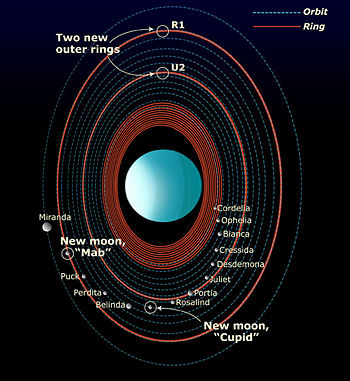Uranus (planet)
Uranus is the seventh planet from the Sun. It is a gas giant (also known as a Jovian planet, after the planet Jupiter).
Parameters for classification as a planet
Uranus is classified as a planet by the International Astronomical Union for meeting the following criteria:[1]
- Orbits the sun;
- Has mass sufficient for its gravity to form a nearly round shape;
- Has mass sufficient for gravity to clear a path in its orbit.
Physical Characteristics
Uranus's distance from the sun is about nineteen and a half times that of earth (19.6 AU), and with a mass fourteen times that of Earth (14 Earth masses), is the lightest of the outer planets. It has a much colder core than the other gas giants, and radiates very little heat into space.[2]
Rotational Characteristics
Uniquely among the planets, it orbits the Sun on its side with the poles pointing in the axial plane almost directly at the sun in the orbital plane; its axial tilt is over ninety degrees to the ecliptic. While its polar orientation switches back and forth as it orbits the sun, this means that the seasons last for extreme periods of time, winter for example lasting 42 earth years. [3]
Natural satellites
Uranus has twenty-seven satellites, all named after Shakespearean characters, the largest being Titania, Oberon, Umbriel, Ariel and Miranda. Unlike some moons of the other giant planets and Earth's, none of them are larger than the dwarf planets Eris and Pluto.
References
- ↑ Honey, I Shrunk the Solar System NASA. “The International Astronomical Union has decided that, to be called a planet, an object must have three traits. It must orbit the sun, be massive enough that its own gravity pulls it into a nearly round shape, and be dominant enough to clear away objects in its neighborhood.”
- ↑ Hawksett, David; Longstaff, Alan; Cooper, Keith; Clark, Stuart (2005). 10 Mysteries of the Solar System. Astronomy Now. Retrieved on 2006-01-16.
- ↑ The effect of rotation National Meritime Museum

